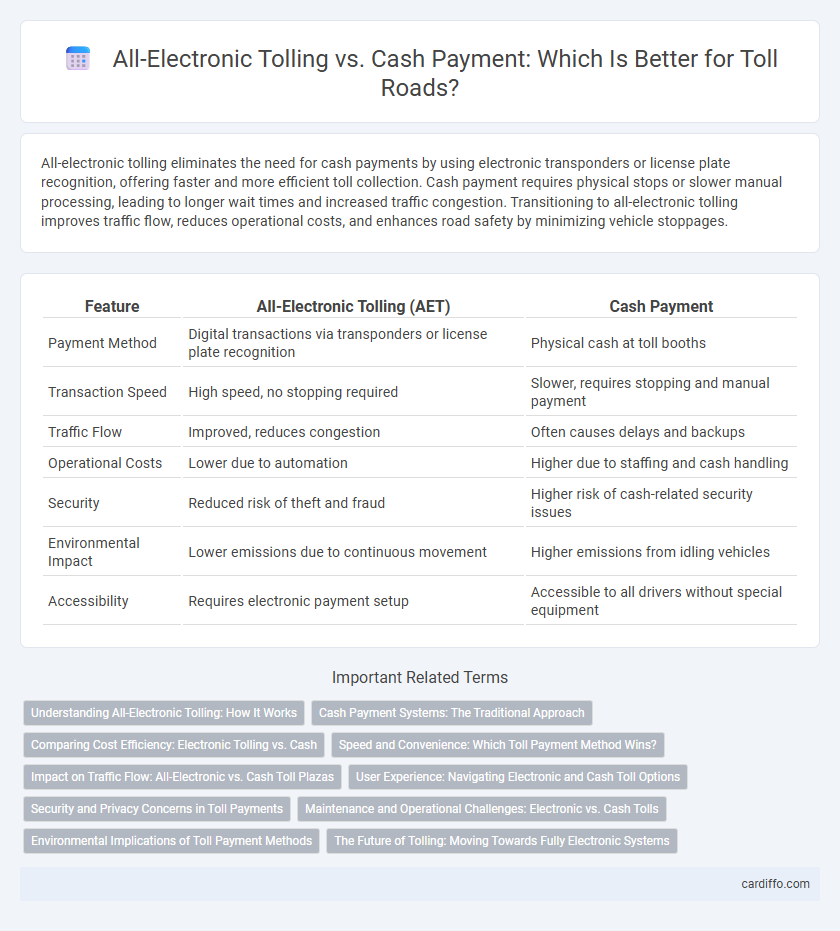All-electronic tolling eliminates the need for cash payments by using electronic transponders or license plate recognition, offering faster and more efficient toll collection. Cash payment requires physical stops or slower manual processing, leading to longer wait times and increased traffic congestion. Transitioning to all-electronic tolling improves traffic flow, reduces operational costs, and enhances road safety by minimizing vehicle stoppages.
Table of Comparison
| Feature | All-Electronic Tolling (AET) | Cash Payment |
|---|---|---|
| Payment Method | Digital transactions via transponders or license plate recognition | Physical cash at toll booths |
| Transaction Speed | High speed, no stopping required | Slower, requires stopping and manual payment |
| Traffic Flow | Improved, reduces congestion | Often causes delays and backups |
| Operational Costs | Lower due to automation | Higher due to staffing and cash handling |
| Security | Reduced risk of theft and fraud | Higher risk of cash-related security issues |
| Environmental Impact | Lower emissions due to continuous movement | Higher emissions from idling vehicles |
| Accessibility | Requires electronic payment setup | Accessible to all drivers without special equipment |
Understanding All-Electronic Tolling: How It Works
All-electronic tolling (AET) eliminates cash transactions by using electronic transponders and license plate recognition cameras to automatically charge drivers. Vehicles equipped with transponders are detected via radio frequency identification (RFID), while cameras capture images of license plates for billing accounts without a device. This system accelerates traffic flow, reduces congestion, and minimizes the need for staffed toll booths, providing a seamless toll payment experience.
Cash Payment Systems: The Traditional Approach
Cash payment systems for toll collection rely on physical currency exchanges at toll plazas, requiring staffed booths and manual processing. This traditional approach often leads to traffic congestion, increased operational costs, and delays compared to all-electronic tolling methods. Despite these challenges, cash payment remains accessible for drivers without electronic transponders or credit accounts, ensuring inclusivity in toll collection.
Comparing Cost Efficiency: Electronic Tolling vs. Cash
All-electronic tolling systems reduce operational costs by eliminating the need for cash handling, manual toll booth staffing, and physical infrastructure maintenance. Electronic toll collection improves transaction speed and accuracy, minimizing congestion-related expenses and fuel consumption. Cash payment systems incur higher labor expenses, slower processing times, and increased risk of revenue leakage due to human error and counterfeit currency.
Speed and Convenience: Which Toll Payment Method Wins?
All-electronic tolling significantly reduces congestion by enabling seamless vehicle passage without stopping, enhancing speed and convenience compared to cash payments that require physical stops and manual transactions. Electronic toll systems use RFID tags or license plate recognition, minimizing delays and improving traffic flow, while cash payments introduce variable wait times and operational inefficiencies. Data from transportation agencies show a consistent decrease in commute times and increased user satisfaction with all-electronic tolling systems over traditional cash methods.
Impact on Traffic Flow: All-Electronic vs. Cash Toll Plazas
All-electronic tolling significantly improves traffic flow by eliminating the need for vehicles to stop or slow down at toll plazas, reducing congestion and delays. In contrast, cash payment lanes require vehicles to halt for manual transactions, causing bottlenecks and increased travel times during peak hours. Transitioning to all-electronic systems decreases emissions and enhances roadway efficiency by maintaining continuous vehicle movement.
User Experience: Navigating Electronic and Cash Toll Options
All-electronic tolling enhances user experience by eliminating cash transactions, allowing seamless travel through toll points via transponders or license plate recognition, reducing congestion and wait times. In contrast, cash payment options require stopping, handling change, and more manual processing, which can slow traffic flow and increase user frustration. Transitioning to all-electronic tolling leverages technology-driven convenience, improving efficiency and consistency in toll road navigation.
Security and Privacy Concerns in Toll Payments
All-Electronic Tolling (AET) systems enhance security by eliminating cash handling, reducing theft risks and physical contact points vulnerable to fraud. In AET, encrypted data transmission and secure vehicle identification technologies help protect user privacy, though concerns remain about tracking and data storage by toll agencies. Cash payments offer anonymity but increase exposure to counterfeit currency and staff vulnerabilities, making AET a more secure yet privacy-sensitive alternative.
Maintenance and Operational Challenges: Electronic vs. Cash Tolls
All-electronic tolling systems reduce maintenance costs by eliminating physical toll booths and cash handling equipment, lowering risks of mechanical failures and vandalism. Cash payment systems require frequent maintenance due to wear and tear on toll booths, cash counters, and security measures to prevent theft. Electronic tolling streamlines operational efficiency by automating transactions, whereas cash toll collection demands continuous staffing, increasing labor expenses and error rates.
Environmental Implications of Toll Payment Methods
All-electronic tolling significantly reduces vehicle idling times compared to cash payment methods, decreasing carbon emissions and improving air quality near toll plazas. The elimination of physical booths and cash transactions reduces paper waste and energy consumption associated with cash handling and toll booth operation. Transitioning to all-electronic tolling supports sustainable transportation infrastructure by lowering greenhouse gas emissions tied to toll collection processes.
The Future of Tolling: Moving Towards Fully Electronic Systems
Fully electronic tolling systems eliminate the need for cash transactions by using RFID tags, license plate recognition, and mobile apps, resulting in faster traffic flow and reduced congestion. Governments worldwide are adopting all-electronic tolling to enhance efficiency, lower operational costs, and improve environmental sustainability by minimizing vehicle idling times. The transition towards fully electronic toll systems is supported by advancements in sensor technology and real-time data analytics, enabling seamless toll collection and accurate enforcement.
All-Electronic Tolling vs Cash Payment Infographic

 cardiffo.com
cardiffo.com